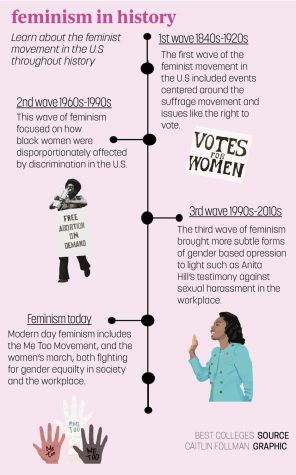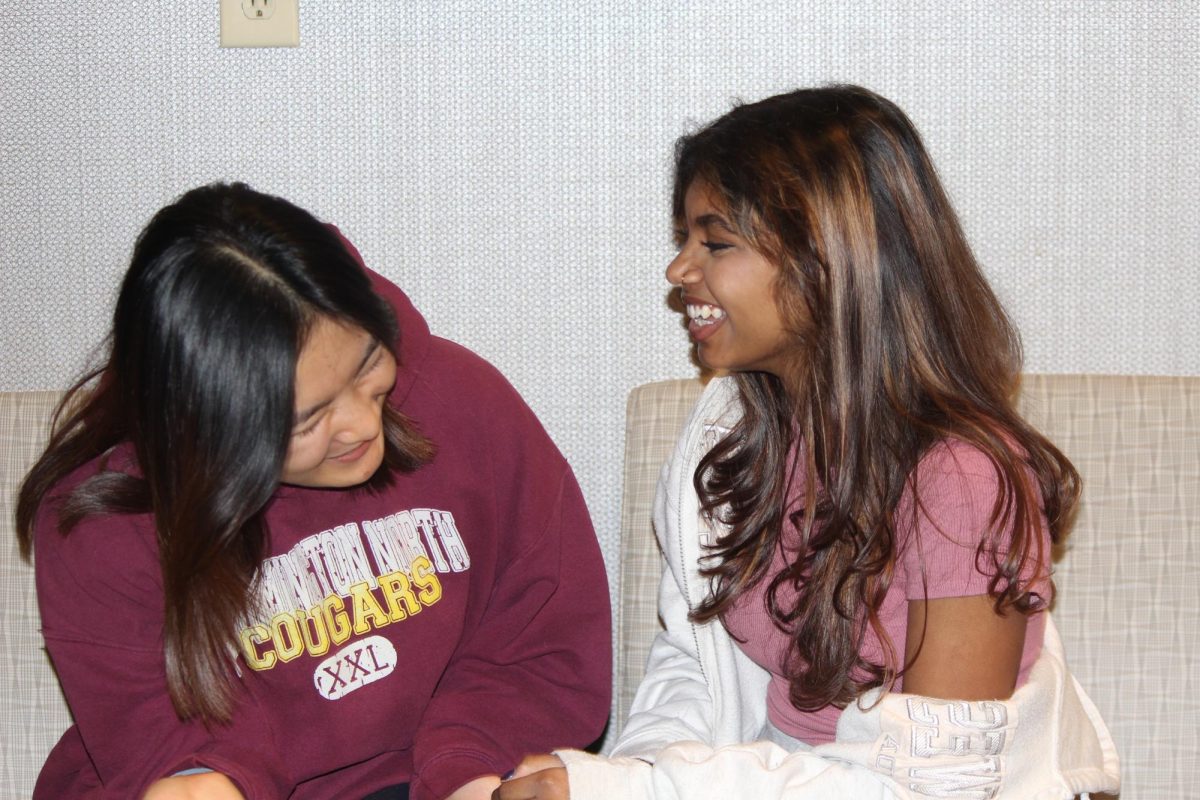According to PEW Research Center, 80% of adults believe in gender equality, yet only 61% of women identify as feminists. Junior Amanda Pan, a self-titled feminist, said this is because the definition of feminism is incredibly challenging, and is constantly changing.
“Not everyone accepts the same definition of feminist. Some see it as a threat to men and masculinity, and some see it as a threat to our historic society. Right now, people are challenging movements for equal rights for trans students or LGBTQ+ and just these diversity initiatives, which isn’t what feminism has always been. When you think about feminism everyone should want women to be empowered and have that equal treatment,” Pan said. “It doesn’t have to be at the sacrifice of somebody else, it’s just to say, we are at the same playing field. Why would anybody not be in that stance?”
Pan said one of the fundamental changes she has seen in feminism throughout her life is moving away from putting down a particular group of people and more towards uplifting and inclusivity.
“I have noticed that in popular culture, especially if you look at 2016 or 2017, a lot of feminism was centered on women being equal to men. But the thing is, it dumbed down girls that liked pink or dresses or stuff like that. It was anti-feminist, in a way,” Pan said. “Now, a lot of the time, feminism is more centered around inclusivity. It is very focused on intersectionality.”
Rocío Ferreira, a women’s and gender studies professor, said throughout history, feminism has been observed in waves.
“We have really only seen four defined waves, but many involved in the field have speculated an oncoming fifth wave of feminism,” Ferreira said. “The first wave was in sync with the abolitionist movement, and fights for black freedom. The second wave was far more political, and centered around what we know today as ‘white feminism.’ The third wave is more recent, in the late 1900s. It was centered around attacking male ideals. The fourth wave was similar, which is why some choose to group them together. The difference was, it focused on putting people done. And now, we see an oncoming fifth wave, focused on not only uplifting all women, but uplifting all minorities.”
Pan said she has noted feminism moving more toward acknowledging other discrimination factors. She said to be a modern feminist, it is crucial to acknowledge other factors of oppression.
“You need to acknowledge that race and ethnicity and sexuality also contribute to the discrimination faced. I feel like acknowledging all of that is just an integral part of being a feminist now,” she said. “For example, a lot of feminist literature is written by white women, and you can tell by the way they speak about minorities, it kind of diminishes the racial injustice in favor of feminism, and that is something that modern-day feminism is moving away from.”
AP Research and AP Seminar teacher Allison Malloy said seeing women holding positions of power and

having a more excellent voice is one of the most significant evolutions she has seen for the feminist movement throughout her lifetime.
“One of the moments recently that I found to be really life-changing and powerful in women’s history was Kamala Harris’ induction as vice president. Sitting there and watching that with my daughter and having that moment, having Hillary Clinton as a presidential candidate, the fact that people had the opportunity to vote for her; these are historic moments for women, regardless of your political standing,” she said. “We are watching the role of women evolve on local levels but also in some of the most prominent offices in the world where we are seeing more female representatives and senators, and they are getting places at the table they weren’t getting previously. When I was in high school or younger, we didn’t have those things.”
CHS graduate Sage Mehta, former co-president of the Students Coalition for Consent club, said she is constantly belittled for being a woman who is active in the political world.
“As a woman, especially trying to work in politics and government with officials and legal organizations, I am constantly frowned upon or treated differently because I am a woman. I don’t see my male peers getting the same treatment,” Mehta said. “It feels like women are always treated like an anomaly or unqualified or unspoken. That angers me the most. But I’ve been working in this field for a bit now, and I’ve really seen changes. People have been taking the opinions of women more seriously, and a more recent example of this is Marianne Williamson, which we can see with her running for president. ”
Both Pan and Malloy said they were frustrated with the double standards that continue to exist between men and women.
“I remember the whole thing with Taylor Swift in 2017 with her and Kanye West, people were a lot more harsh on her because she was a woman. Even then, with the phone call and when people saw it was fake, they weren’t backlashing Kanye as much as they were trashing Taylor before,” Pan said. “Women in the media have been seen as sluts for so long. They’ve been portrayed like someone stupid. But the media doesn’t bat an eye if a man does the same thing, which is frustrating.”
“It was frustrating hearing people talk about boys doing things that they shouldn’t be in contrast to girls, and it’s just the language used. As someone a bit more fiery and passionate, the number of times words were used to describe me that was– explicit– I’m going to say it that way, you know, the B word gets thrown around to women,” Malloy said. “I found that frustrating as a woman with strong opinions, and when someone labels you that way, you’re constantly like, ‘Well, am I not allowed to have an opinion?’
“For kids that play sports, when they wear their sports or their sweatpants with the logo, no one thinks twice about what that looks like when the boy’s basketball team does that. At my high school, there would always be conversations about, “Should the girls dress up before games?” or ‘It is not appropriate for them to wear sweats,’ or ‘They must be a tomboy if they like sports,’ and I think that the biggest frustration is how quickly everything had to be within a certain box,” she said.
Malloy said she has observed a change in this attitude from when she was younger.
“It feels like looks and clothing play a less prominent role in how we define others, and we focus less on stereotypes or preconceived notions of what makes someone a woman,” Malloy said.
Ultimately, Malloy said the biggest change in feminism she has seen has been focusing more on the empowerment of all women, rather than putting down certain groups of women.
“On a basic level, the thing is equity and access. When we look at making sure that women are empowered, where it be biological or identified, the emphasis is on the equal playing field, and the equity in peace,” Malloy said. “Again, it comes back to empowerment, but it is a vague definition, and we aren’t really sure on what that means.”































![British royalty are American celebrities [opinion]](https://hilite.org/wp-content/uploads/2024/03/Screenshot-2024-03-24-1.44.57-PM.png)




















![Review: “The Iron Claw” cannot get enough praise [MUSE]](https://hilite.org/wp-content/uploads/2024/04/unnamed.png)
![Review: “The Bear” sets an unbelievably high bar for future comedy shows [MUSE]](https://hilite.org/wp-content/uploads/2024/03/unnamed.png)
![Review: “Mysterious Lotus Casebook” is an amazing historical Chinese drama [MUSE]](https://hilite.org/wp-content/uploads/2024/03/0.webp)
![Thea Bendaly on her Instagram-run crochet shop [Biz Buzz]](https://hilite.org/wp-content/uploads/2024/03/IMG_0165-1200x838.jpg)
![Review: Sally Rooney’s “Normal People,” is the best book to read when you are in a time of change [MUSE]](https://hilite.org/wp-content/uploads/2024/03/20047217-low_res-normal-people.webp)
![Review in Print: Maripaz Villar brings a delightfully unique style to the world of WEBTOON [MUSE]](https://hilite.org/wp-content/uploads/2023/12/maripazcover-1200x960.jpg)
![Review: “The Sword of Kaigen” is a masterpiece [MUSE]](https://hilite.org/wp-content/uploads/2023/11/Screenshot-2023-11-26-201051.png)
![Review: Gateron Oil Kings, great linear switches, okay price [MUSE]](https://hilite.org/wp-content/uploads/2023/11/Screenshot-2023-11-26-200553.png)
![Review: “A Haunting in Venice” is a significant improvement from other Agatha Christie adaptations [MUSE]](https://hilite.org/wp-content/uploads/2023/11/e7ee2938a6d422669771bce6d8088521.jpg)
![Review: A Thanksgiving story from elementary school, still just as interesting [MUSE]](https://hilite.org/wp-content/uploads/2023/11/Screenshot-2023-11-26-195514-987x1200.png)
![Review: When I Fly Towards You, cute, uplifting youth drama [MUSE]](https://hilite.org/wp-content/uploads/2023/09/When-I-Fly-Towards-You-Chinese-drama.png)
![Postcards from Muse: Hawaii Travel Diary [MUSE]](https://hilite.org/wp-content/uploads/2023/09/My-project-1-1200x1200.jpg)
![Review: Ladybug & Cat Noir: The Movie, departure from original show [MUSE]](https://hilite.org/wp-content/uploads/2023/09/Ladybug__Cat_Noir_-_The_Movie_poster.jpg)
![Review in Print: Hidden Love is the cute, uplifting drama everyone needs [MUSE]](https://hilite.org/wp-content/uploads/2023/09/hiddenlovecover-e1693597208225-1030x1200.png)
![Review in Print: Heartstopper is the heartwarming queer romance we all need [MUSE]](https://hilite.org/wp-content/uploads/2023/08/museheartstoppercover-1200x654.png)























![Review: Ladybug & Cat Noir: The Movie, departure from original show [MUSE]](https://hilite.org/wp-content/uploads/2023/09/Ladybug__Cat_Noir_-_The_Movie_poster-221x300.jpg)

![Review: Next in Fashion season two survives changes, becomes a valuable pop culture artifact [MUSE]](https://hilite.org/wp-content/uploads/2023/03/Screen-Shot-2023-03-09-at-11.05.05-AM-300x214.png)
![Review: Is The Stormlight Archive worth it? [MUSE]](https://hilite.org/wp-content/uploads/2023/10/unnamed-1-184x300.png)


